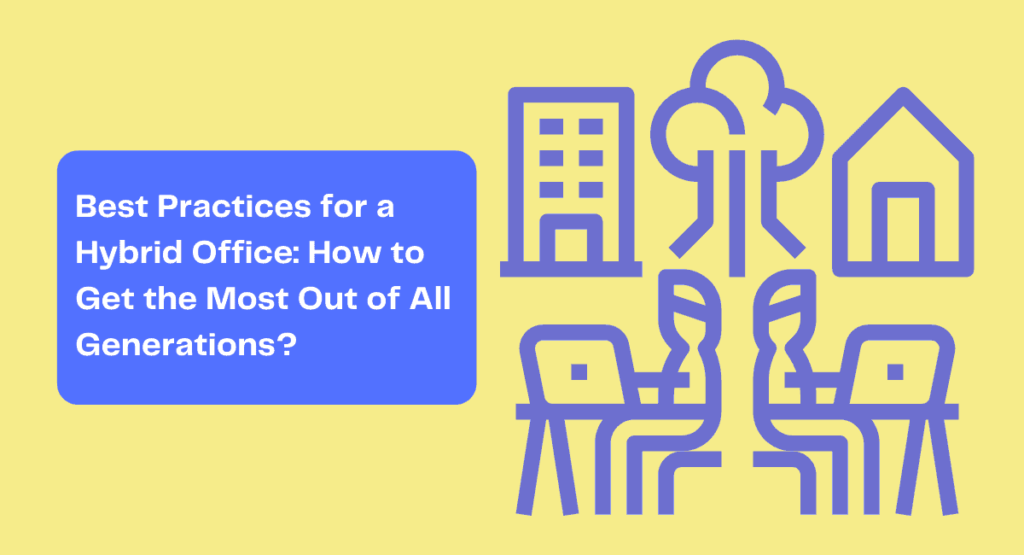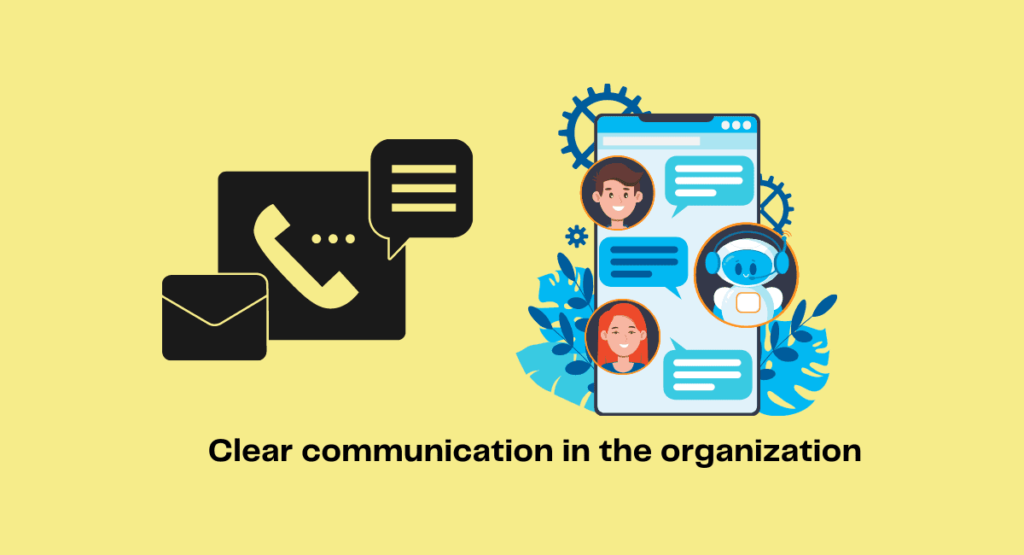Best Practices for a Hybrid Office


A hybrid office is the future of work. By 2050, it is estimated that 75% of the workforce will be working remotely, at least part-time.
Businesses are starting to have a hybrid office policy, allowing some employees to work in the office on certain days and remotely on others.
This flexibility appeals to all generations of workers, from baby boomers to Gen Z. It’s important to understand the best practices for a hybrid office to create a productive and efficient, successful hybrid workplace for all your employees.
Let’s dive in!
Establish clear communication guidelines and expectations

“The office that has a home environment but also a working environment”. Insightrix.
For a hybrid office, clear communication is key to maintaining productivity, efficiency, and effectiveness. By establishing guidelines and expectations, all employees will know what is expected of them in terms of communication (i.e., how often they should check-in, what kind of information needs to be shared, etc.). This will help to prevent any misunderstandings.
Regular check-ins (both in-person and via video conference) are essential to ensure that everyone is on the same page and that tasks are completed as planned. If you check in regularly, you can catch any potential problems early on. This will help you to address them before they become bigger issues.
Hybrid working can be a great way to bring people together, even when they’re physically apart. So take the time to celebrate the big and small wins as a team. This will help keep morale high and motivate everyone to continue working hard.
How to create a communication policy for a hybrid office
Creating a communication policy for a hybrid office can seem daunting, but by following these simple steps, you can have one in place that works for everyone.
- Determine what the goals of the policy are:
- Are you looking for improved communication between office workers and remote workers?
- Greater transparency between management and staff?
- Fewer missed deadlines?
Once you know what you want to achieve, you can put the policy together.
- Decide all employees will use which communication channels.
- Will you rely primarily on email?
- Or will you use a mix of email, instant messaging, video conferencing, and face-to-face meetings?
Once you’ve decided on the channels, make sure that everyone is aware of them and knows how to use them.
- Set some guidelines for frequency and timing of communication.
- How often should employees check in with each other?
- When is the best time to have video conferences?
Setting these guidelines can ensure that everyone is on the same page and avoid potential conflict.
- Put it all in writing and distribute it to all employees. This will ensure that everyone is aware of the policy and knows what is expected of them.
Tips for communicating with employees in a hybrid office

According to a study by the Leesman index, over 80% of workers confirm that employees can do many critical parts of their jobs easily from home. Their jobs such as:
- Meeting plan
- Individual Routine tasks
- Audio Conferences
- Telephone Conversations
- Reading
- Individual Focus Work. Desk-based.
- Business Confidential Discussions.
Business communication has been evolving for the past several decades. The introduction of new technologies has allowed businesses to communicate more than ever before.
There are many tools that people use for communication in business. These include email, instant messaging, video conferencing, and social media.
If you work in a hybrid workplace, here are some tips for communicating with your employees:
- When possible, use video conferencing in in-person collaboration.
- If you need to share confidential information, consider using a secure messaging app.
- Use instant messaging or chatbots for quick questions or updates.
- Email is still a great way to share important documents or longer messages.
Encourage employees to use a variety of communication channels.
With a hybrid workplace, it’s essential to encourage employees to use a variety of communication channels. This will ensure that everyone is on the same page and that no essential information is overlooked.
Email, instant messaging, video conferencing, and face-to-face meetings are some of the most popular channels. The media communication option can create a communication policy that works for everyone.
A hybrid office means both are working from the office and remotely, which has become a trend among employers and employees. As an employer, if you are looking forward to establishing best practices for your hybrid office, then clear communication is the key.
You can set up guidelines and expectations for all employees in terms of communication. This will help to avoid any confusion or miscommunication later on.
Check-ins in person and via video conference is crucial to ensure that everyone is aligned and tasks are being completed as planned. By checking in regularly, you can identify potential issues early on and address them before they get worse.
Do not forget to celebrate successes! Hybrid offices provide an opportunity to bring people together even when they are physically apart. So take some time out to celebrate big and small wins as a team. This will help maintain morale and motivate employees.
Consider communication preference based on the generation of workers.

When creating a communication policy for your hybrid office, consider how each generation prefers to communicate. For example, baby boomers prefer face-to-face interaction, while millennials are more comfortable with text-based communication like email or chat.
If you have team members working remotely, be sure to set up regular check-ins so they feel included in the team. Employees can do this through video conferencing or a simple weekly check-in email.
Finally, make sure that your hybrid office is equipped with the right technology. Hybrid offices need to have a reliable internet connection and a good video conferencing system. If you are not sure what to get for your office, there are plenty of resources online that can help you.
Encourage collaboration and teamwork in a hybrid work model.
Encouraging collaboration and teamwork among employees are critical in a hybrid work model. Having employees work together in-office and remotely can communicate and collaborate more efficiently.
This will help them to be more productive and efficient. Additionally, teamwork can help to build relationships among coworkers and create a more positive work environment.
Collaboration Tools

Employees can use various collaboration tools and software for a hybrid work model. Each tool has its unique features that can be used to collaborate with others.
Some popular collaboration tools software include:
Zoom, Ms.Team, and Google Meet.
This video conferencing software allows users to meet with each other online. It also has a screen-sharing feature for collaborative projects.
By using collaboration tools, employees can communicate and collaborate more efficiently. This will help improve how productive and efficient employees are at work. Additionally, it can also help build relationships among coworkers and create a more positive work environment.
Google Docs.
This is a word processing software that allows users to create and edit documents online. It also has a chat feature that allows coworkers to communicate and collaborate in real-time.
Slack.
This messaging app allows users to communicate with each other through private or public channels. It also has a video call feature for collaborative meetings.
Respect the different working styles of each generation

Businesses must respect the different working styles of each generation.
For example, baby boomers generally prefer to work in office spaces, while millennials are more likely to favor remote work. By accommodating the preferences of all employees, businesses can create a work environment that is both productive and efficient.
In addition, businesses should also consider the different strengths of each generation. For example, baby boomers tend to be more experienced and detail-oriented, while millennials are often more tech-savvy and adaptable. By leveraging the strengths of all employees, businesses can create a well-rounded workplace capable of meeting any challenge.
Promote work/life balance
It’s no secret that the traditional work model is no longer feasible for the majority of people. The 9-5 workday doesn’t work for those with young children, caring for elderly parents, or those who have other obligations outside of work. As a result, many employees are struggling to find a work-life balance that works for them.
There are a few things that employers can do to promote better work-life balance for their employees. First, they can give employees the option to work from home. This can help to eliminate the need for childcare or long commutes.
Second, they can offer flex time or flexible scheduling. Employees can now set their own schedules as long as they complete their work. Finally, employers can provide additional paid time off for employees to use as they see fit. Employees can use this for vacations, sick days, or personal days.
Employers can help their employees find a better work/life balance by offering these options. In turn, this can lead to higher morale and increased productivity.
Celebrate diversity

One of the benefits of the hybrid office model is that it helps to celebrate diversity. With more individuals working remotely, there is a growing need for office space to be flexible and adaptable.
This is possible with the hybrid approach, which allows employees to pick when and where they work. The hybrid model can help create a more diverse workforce, as geographical boundaries do not limit employees.
The hybrid model allows employees of all backgrounds and lifestyles to participate in the workplace. By embracing the hybrid office model, companies can create an inclusive environment that welcomes all types of talent.
In addition, the hybrid work model can also help promote work-life balance, as employees have more control over their work schedules. As a result, the hybrid office model can help to create a more diverse and inclusive workplace.
Celebrate individual strengths and weaknesses
We all have unique strengths and weaknesses, and it’s important to celebrate both. Our strengths help us achieve our goals and excel in our careers, while our weaknesses can hold us back and make us feel like we’re not good enough.
But it’s important to remember that our weaknesses are just as essential as our strengths. Strength and weakness make us who we are and help us to empathize with others.
Face-to-face interactions are a great way to celebrate our strengths and weaknesses. By interacting with others, we can learn about their strengths and how they’ve overcome their weaknesses. This helps us to understand them better and also learn from them.
They can learn from us and understand our unique perspectives. Celebrating our strengths and weaknesses is an essential part of company culture. It helps create a more cohesive and collaborative environment where everyone can feel valued for who they are.
Foster a sense of community within the office

In our increasingly technology-driven world, it’s easy for workers to feel disconnected from their colleagues. This can lead to isolation and resentment, which can damage morale and productivity.
One way to foster a sense of community within the office is to encourage employees to interact with one another personally. Employees can do this by organizing social events, such as after-work drinks or potlucks, or simply encouraging employees to take breaks together in the kitchen or lounge area.
Creating opportunities for social interaction will help employees build relationships and feel more connected to their colleagues. As a result, they’ll be more likely to cooperate and collaborate, leading to a more cohesive and successful work environment.
Conclusion
What’sWhat’s the answer to the question of how can employers and employees alike maximize productivity and minimize conflict in this era of constant technological change?
The answer is a hybrid office. A hybrid office allows for both flexibility and structure. Employees may work from home if they need to, but they also attend team meetings and major projects in the office.
This way, everyone has the freedom they need while still being held accountable.
If you’re an employer considering transitioning to a hybrid office, there are some things you should keep in mind. For example, make sure that all team members have access to the same technology, working remotely or in-house. And be open to accommodating different hours so that people can work when they’re most productive.


